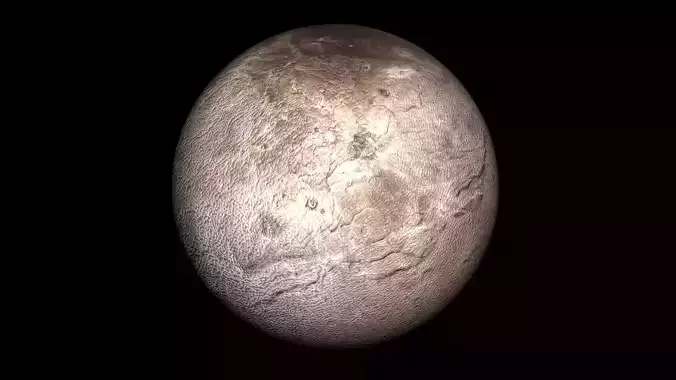1/14
DescriptionCharon Moon (Charon) (/ˈkɛərɒn, -ən/ KAIR-on, -ən or /ˈʃærən/ SHARR-ən),[note 1] or (134340) Pluto I, is the largest of the five known natural satellites of the dwarf planet Pluto. It has a mean radius of 606 km (377 mi). Charon is the sixth-largest known trans-Neptunian object after Pluto, Eris, Haumea, Makemake, and Gonggong. It was discovered in 1978 at the United States Naval Observatory in Washington, D.C., using photographic plates taken at the United States Naval Observatory Flagstaff Station (NOFS). With half the diameter and one-eighth the mass of Pluto, Charon is a very large moon in comparison to its parent body. Its gravitational influence is such that the barycenter of the Plutonian system lies outside Pluto, and the two bodies are tidally locked to each other. The dwarf planet systems Pluto–Charon and Eris–Dysnomia are the only known examples of mutual tidal locking in the Solar System, though it is likely that Orcus–Vanth is another. The reddish-brown cap of the north pole of Charon is composed of tholins, organic macromolecules that may be essential ingredients of life. These tholins were produced from methane, nitrogen, and related gases which may have been released by cryovolcanic eruptions on the moon or may have been transferred over 19,000 km (12,000 mi) from the atmosphere of Pluto to the orbiting moon. The New Horizons spacecraft is the only probe that has visited the Pluto system. It approached Charon to within 27,000 km (17,000 mi) in 2015. Charon was discovered by United States Naval Observatory astronomer James Christy, using the 1.55-meter (61 in) telescope at United States Naval Observatory Flagstaff Station (NOFS). On June 22, 1978, he had been examining highly magnified images of Pluto on photographic plates taken with the telescope two months prior. Christy noticed that a slight elongation appeared periodically. The bulge was confirmed on plates dating back to April 29, 1965. Subsequent observations of Pluto determined that the bulge was due to a smaller accompanying body. The periodicity of the bulge corresponded to Pluto's rotation period, which was previously known from Pluto's light curve. This indicated a synchronous orbit, which strongly suggested that the bulge effect was real and not spurious. This resulted in reassessments of Pluto's size, mass, and other physical characteristics because the calculated mass and albedo of the Pluto–Charon system had previously been attributed to Pluto alone. The International Astronomical Union formally announced Christy's discovery to the world on July 7, 1978. Doubts about Charon's existence were erased when it and Pluto entered a five-year period of mutual eclipses and transits between 1985 and 1990. This occurs when the Pluto–Charon orbital plane is edge-on as seen from Earth, which only happens at two intervals in Pluto's 248-year orbital period. It was fortuitous that one of these intervals happened to occur soon after Charon's discovery.
Texture Resolution: 1280 x 640
REVIEWS & COMMENTS
accuracy, and usability.














